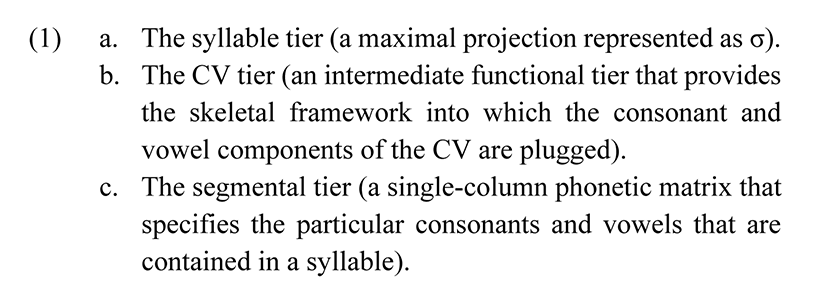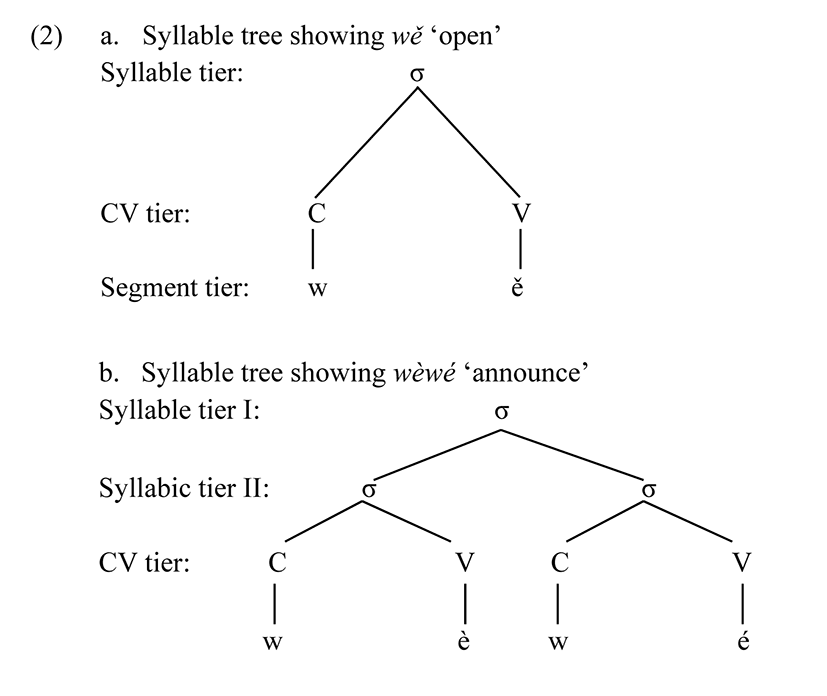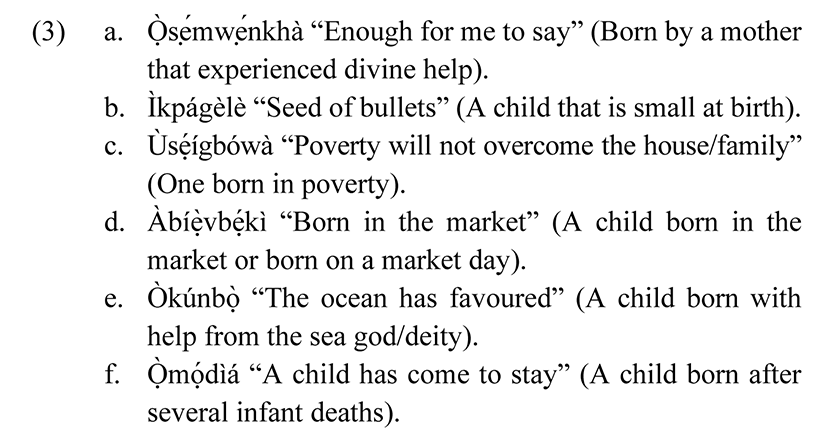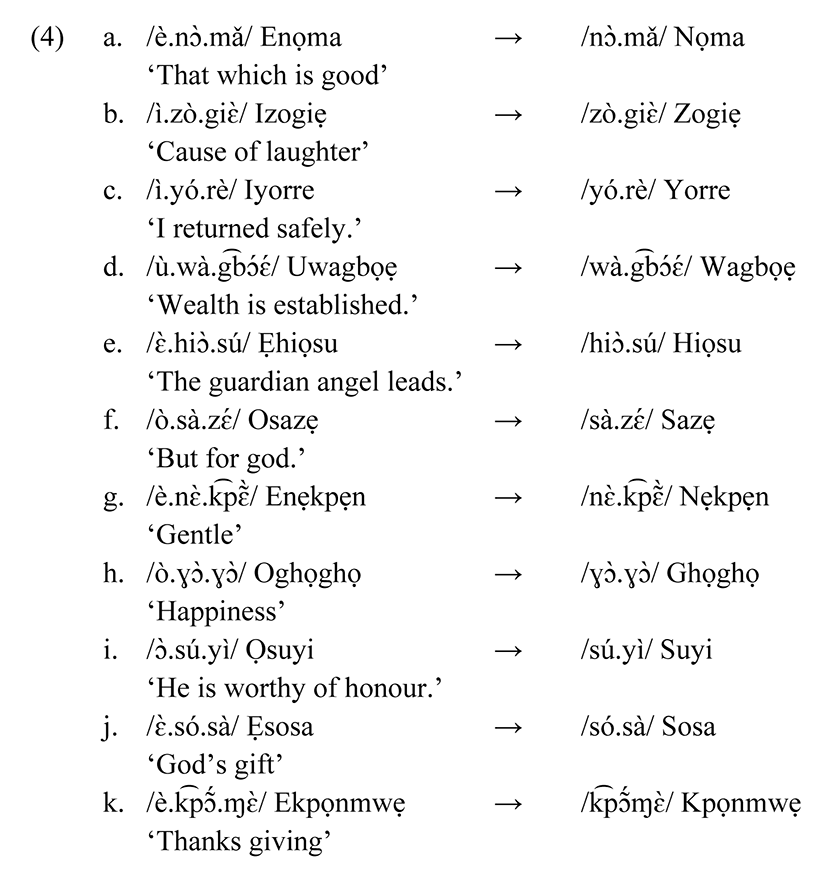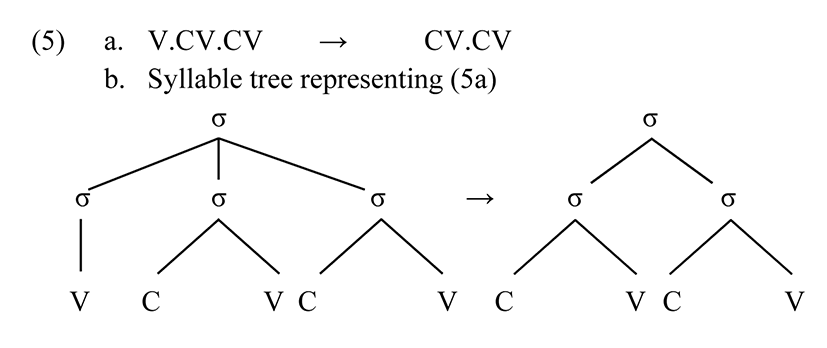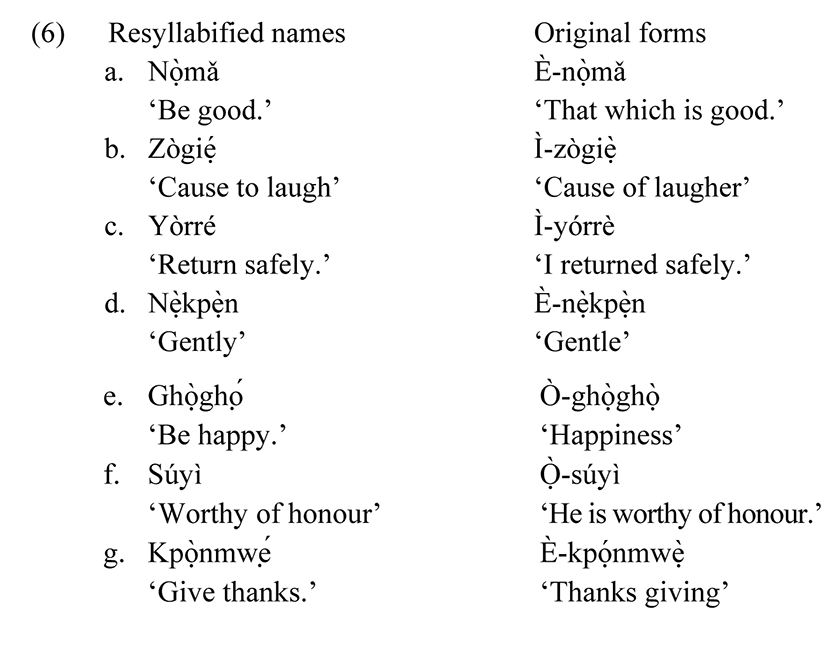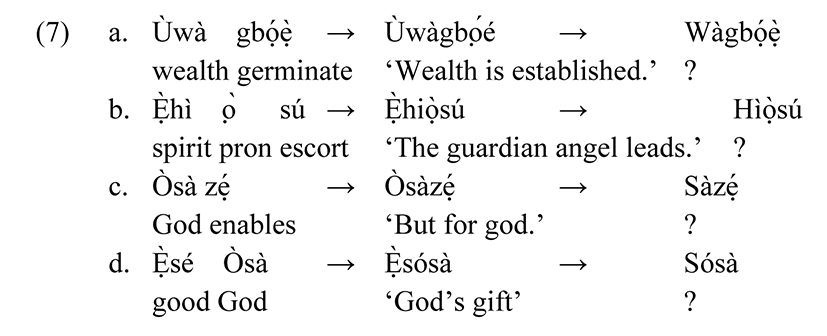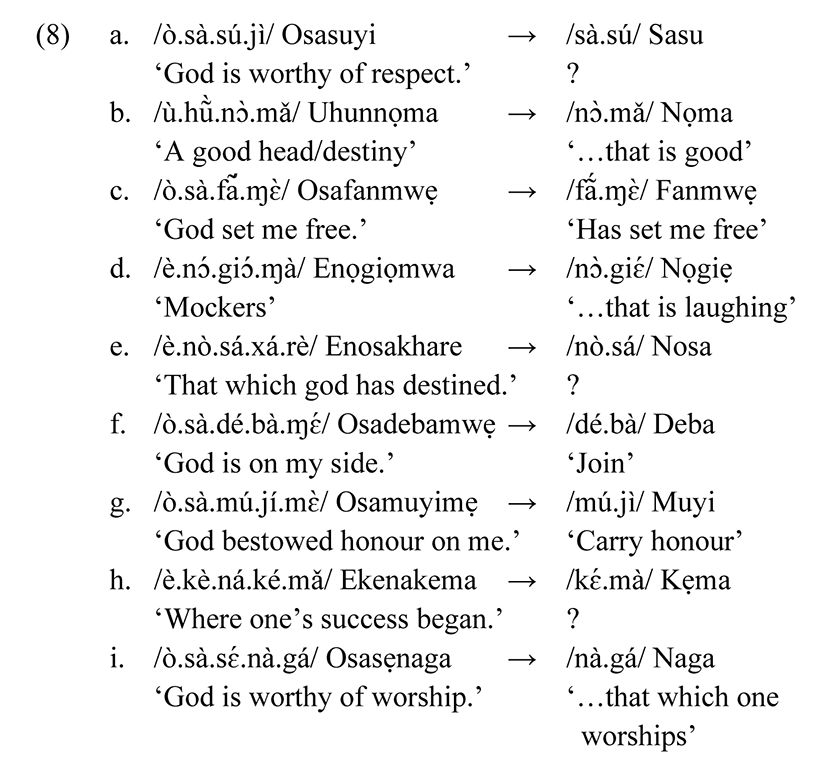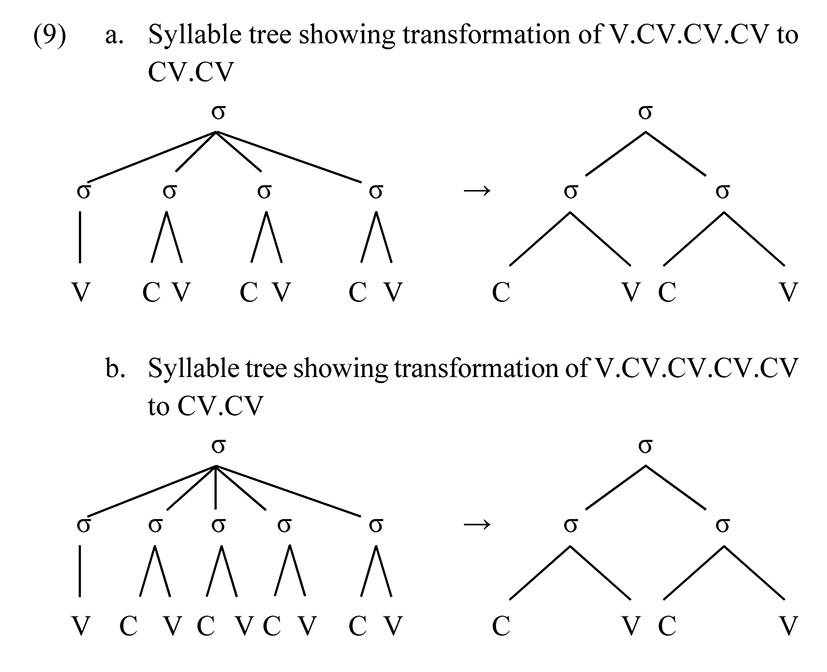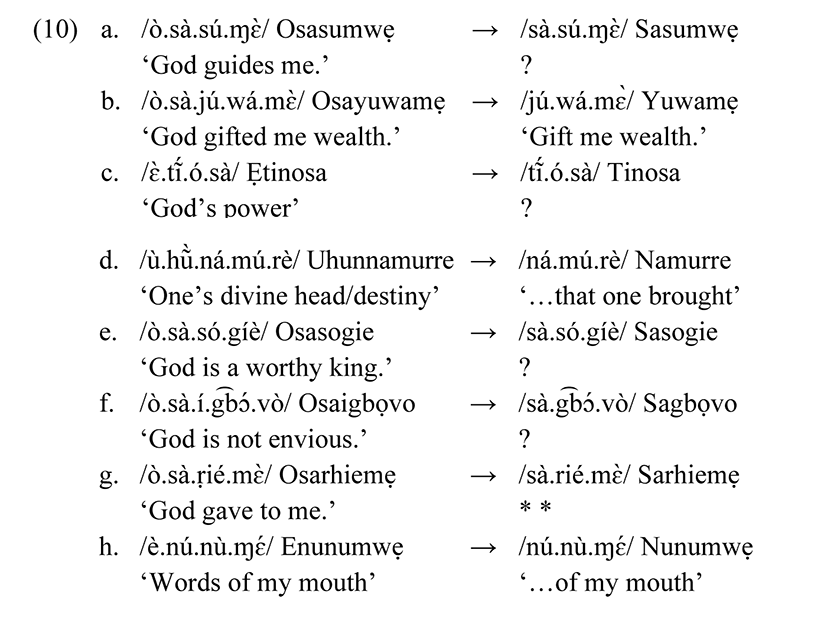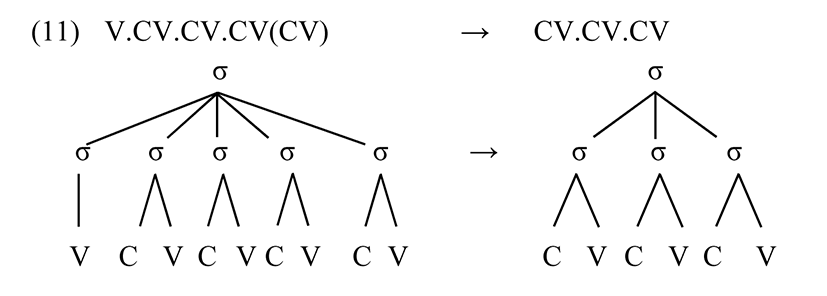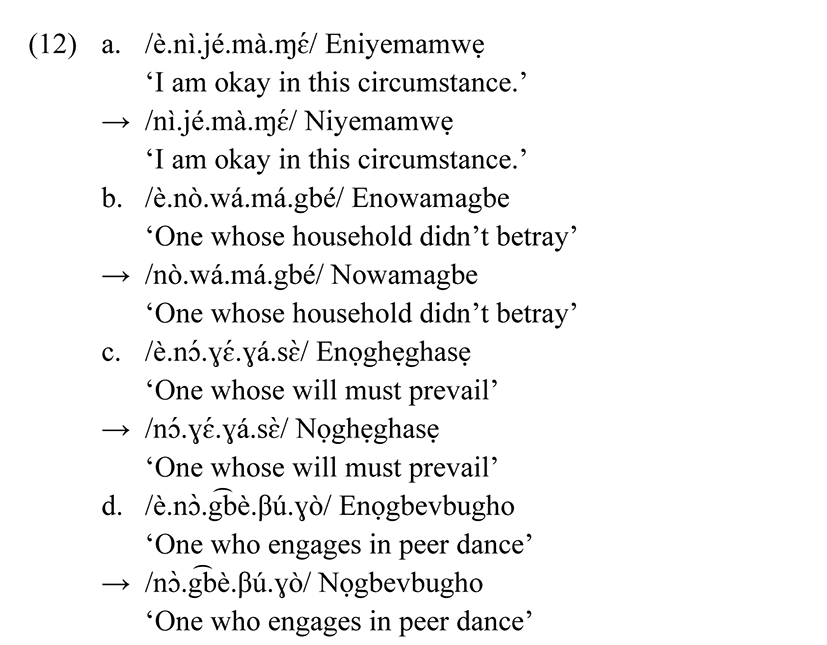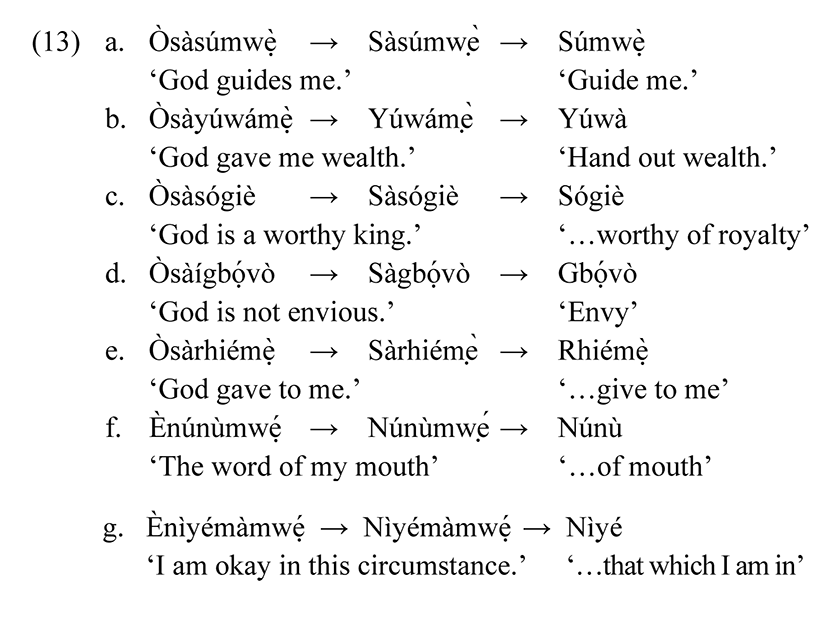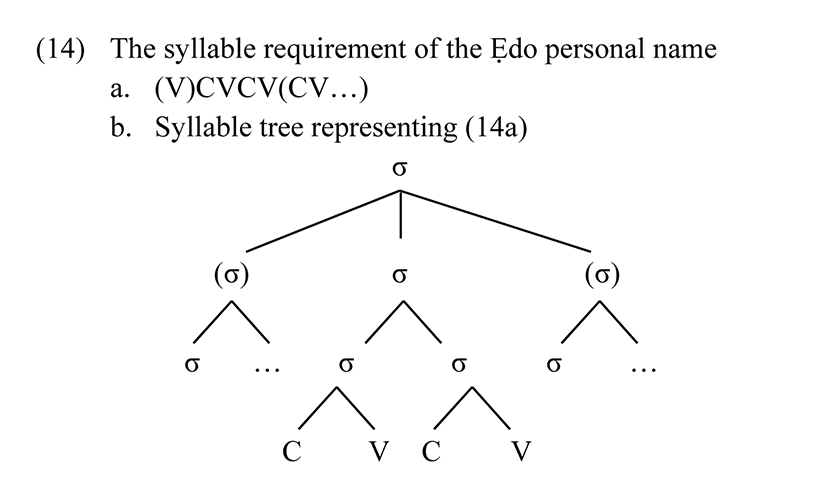1. Introduction
A name is a word by which a person, thing, or place is known or identified. A personal name is the name by which an entity is known. In Ẹdo society, a name is usually given to a person within the first one or two weeks of birth. Ẹdo personal names are mostly complex forms. They are usually composed of several words and are therefore meaningful phrases and sentences. These forms are subsequently compressed in a lexicalization or ‘desentencialization’ process that reduces the entire form into a single word.
Resyllabification refers to a phonological process in which the syllable structure of a word is altered. The alteration could be by addition, substitution, or deletion of any of its parts. Any form of syllable adjustment or readjustment in a word is considered within the domain of resyllabification (Hyman 1975, Yul-Ifode 2007, Oyinloye 2020) and it usually alters the original syllable structure or pattern of the word (Kenstowicz 2006, Ugorji 2013, Ghorbanpour et al. 2019). In this sense, whatever affects the syllable content or count in a word is considered as resyllabification. Desententialisation of names (Agbo 2014) is, therefore, resyllabification to the extent that it affects the syllable patterning of the name onto which it applies. The focus of this study is on the loss of syllable counts (i.e., the reduction in the number of syllables) in Ẹdo names, such that the names are re-syllabified from their original form to one with a reduced number of syllables.
According to the National Population Census of 2006 (National Population Commission 2010), the language has over 1 million speakers who are indigenous to Egor, Oredo, Ikpoba-Okha, Orhionmwon, Uhunmwode, Ovia South-West and Ovia North-East Local Government Areas of Edo State, Nigeria. As Imasuen (1998) observed, Ẹdo native speakers are also found in some locations in Ondo and Delta states. The language is classified as a Proto-North Central Edoid language in Elugbe’s (1989) Edoid language family. It is also classified under the Edoid sub-group of the West Benue Congo family in Williamson & Blench’s (2000) Proto-Benue Congo languages. Related languages include Esan, Ora, Emai and Uneme that are also spoken in Edo state.
This paper examines resyllabification in Ẹdo names. It investigates the syllable patterns in this group of nouns and how they are transformed from longer forms into forms with simpler CVCV patterns. It also investigates the implication of the transformation on the meanings of the names. The remaining parts of the paper are organized as follows: Section 2 presents the research methodology while Section 3 discusses the CV-phonology, which is the adopted theoretical framework. In Section 4, an overview of the personal name in Ẹdo is presented, Section 5, has the analysis of the data, showing the resyllabification process in Ẹdo personal names and the results of the process. The concluding remarks of the paper are contained in Section 6.
2. Methodology
The data used in the study comprise personal names that were gathered from the Ẹdo people around the three municipal local government areas (Oredo, Egor and Ikpoba-Okha) that make up Benin city, the capital city of Edo state, Nigeria. The data were collected over time between December 2016, when our interest in the modification of Ẹdo personal names began, and February 2019 when the verification of collected names was concluded. The names were collected by the researcher who would record whichever re-syllabified name he hears or sees, by means of pen and paper, as he goes about other activities.
Recently, the names that were gathered were taken to Ẹdo native speakers for verification and further discussions on their meanings and complete forms where they are still recognizable. A total of five (5) Ẹdo speakers who are spread across the three local government areas in Benin city participated in this verification process, and the interviews were recorded by means of a digital voice recorder. The verification helped the study to gather information on the acceptability and functionality of the re-syllabified names. After verification, only names that were recognized as acceptable were assumed to enjoy functionality in the Ẹdo society and were further considered in the study. These were organized according to their syllable structures and analysed by way of careful observation, relying on the CV phonological model.
3. CV-Phonology
The CV-phonology (Kahn 1976, Clements & Keyser 1983) accounts for the syllable along the paradigm of generative phonology (Chomsky & Halle 1968). The framework recognizes the CV as a basic syllable structure in natural languages. This is hinged on the observation that a child who is acquiring a language learns, first, CV forms and modifies larger syllable structures such as those with consonant clusters and syllable codas to fit into the CV or a combination of the V or/and the CV structural patterns. The learning of larger syllable structures is delayed until later on in the language acquisition process.
CV-phonology introduces “a third tier in syllable representation” (Clements & Keyser 1983: 8), in addition to existing ones:
Each tier is obligatorily linked to the other by association lines as shown in a monosyllabic wě ‘open’ in (2a) and in disyllabic wèwé ‘announce’ in (2b), below.
In the above diagrams, the ‘C’ and ‘V’ of the CV-tier are seen as different from ‘consonant’ and ‘vowel’ belonging to different levels of formal phonological representations. The CV-tier specifies functional positions of syllable peak, onset, and sometimes coda. The quality of any segment that a language permits in these positions reveals, and depends on, the structure of that language (VanDam 2004).
4. The Personal Name in Ẹdo
A name is an identity. A personal name is a word for identifying a person or animal. It is a proper name (Moruwawon 2010). Personal names in the Ẹdo society are declarative in nature. They are mostly prophetic in that they are believed to determine the future of the person to whom they have been given. Names are, therefore, not just tags placed on people but “are meaningful and reflect the circumstances of birth of the bearer” (Omozuwa 2007: 160). When a person is named, the announcement of the chosen name gives the bearer an identity which the child bears throughout life and with which that person is remembered, even in death. It is for this reason that it is believed that “a child is only properly incorporated as a member of the society after he/she has been appropriately named” (Adeniyi & Yuka 2012: 27). The appropriateness of naming is determined by certain factors at the time at which the name is given. These include i) the person who gives the name (usually the biological father of the child or any elder in the paternal family so designated), ii) the time of naming (usually after seven or fourteen days of birth, in which the child manifests good health) and iii) during a naming ceremony (called Ìzọ̀mọ̀, no matter how elaborate or simple, usually held in the house of the biological father of the new-born or at the family house that is known as Ìgiógbẹ̀).
Ogie (2002) and, later, Adeniyi & Yuka (2012) observed that the type of name given to a child in Ẹdo is motivated by a number of factors, including i) the influence of god or any other divinity in which the parents believe, ii) the mind-set of the parents at the time, iii) the events that surround the birth of the child, iv) the state of health of the mother or child after birth, as well as v) the physical appearance of the new-born. Adeniyi & Yuka (2012: 29) demonstrate different types of Ẹdo names in this regard, as presented below.
These show that personal names in Ẹdo are drawn from the general beliefs of the people. The names are also believed to ultimately guide the child through life and determine their fate in life.
Personal names in Ẹdo “could be phrases or even complete sentences” (Omozuwa 2007: 160) and are often abbreviated for ease of use. This implies that the names are post-lexical forms that have been merged into a single word by desentencialization. Folk assumption holds that personal names in Ẹdo, as in all nouns in the language, obligatorily begin and end in vowels. This initial and final vowel requirement of names in the language is observed, however, not to be obligatory, as this study shows that Ẹdo names are also modified to begin in consonants, rather than vowels.
5. Resyllabification in Ẹdo Personal Names
Structural modifications of personal names in Ẹdo are observed to be CV-driven and mostly result in CVCV syllable structures. Where the modification results in larger forms, this study also observes that they result in forms whose syllable patterns are multiples of the CV structure. Our discussion, here, will begin with those names that are transformed into the CVCV disyllabic forms.
This study observes that there is no personal name that is monosyllabic in Ẹdo. Hence the minimum number of syllables to which names could be reduced is two. Names with three syllables (usually V.CV.CV forms) are transformed to CV.CV by simply deleting the initial vowel as in the following.
In (4), there is a general resyllabification of tri-syllabic names to di-syllabic ones as represented in (5), below.
(5) shows the syllable transformation that occurs in each example in (4) as a result of the deletion of the word-initial vowel in each case. The deleted vowels formed peaks of syllables. The loss of such a vowel results in the loss of a syllable in this language and ultimately results in a reduction in the syllable count from three to two: a resyllabification from tri- to disyllables.
The semantic effects of resyllabification on the names vary according to the morpho-phonemic nature of the deleted vowel. In (4a)–(4c), (4g)–(4i) and (4k), where the deleted vowels are nominal prefixes as represented in (6) below, the resulting CVCV disyllabic names are meaningful.
In (6), it is easy to delete the first syllable in each case since it is a prefix and not a part of a root. In other cases where the name initial syllable vowels are not prefixes but are parts of existing root words, the meanings of the disyllabic name that results from the resyllabification process are affected. Consider (4d)–(4f) and (4j) above, represented as (7) below.
Here, the deleted syllables are parts of root words, hence deleting them alters the meanings of the lexical items to which they originally belong, thereby affecting the meanings of the resulting re-syllabified forms. The re-syllabified names can, however, not be said to be entirely meaningless. The meaning of Wagbọẹ, for example, as an imperative would be “you (pl.) establish” which is also related to the meaning of the original name. Be that as it may, the transformed names are functionally acceptable among the Ẹdo language users, so long as they comply effectively with the CV requirement which motivates their derivation in the language.
There are also cases in which names that are originally composed of four or more syllables are re-syllabified to CVCV patterns. Consider the following, for example.
In (8a)–(8d), VCVCVCV syllable patterns are transformed to CVCV while VCVCVCVCV patterns are transformed to CVCV in (8e)–(8i). The word-initial syllabic vowel is deleted in all cases while an additional one (in (8a)–(8d)) or two (as in (8e)–(8i)) syllable(s) is/are deleted as the case may be. These are illustrated in (9a) and (9b), below.
Since the target realization here is a CV.CV disyllabic pattern, other syllables before or after the meaningful core of the name are deleted until the target pattern is derived. The disyllabic core of an Ẹdo personal name is determined mostly by meaning, in which case a form that is meaningful after all other syllables have been deleted is retained, and sometimes by prestige, where a CV.CV form that is sociolinguistically preferred is retained. Whichever the case, the re-syllabified form that is retained is capable of reminding the Ẹdo speakers of the original name, hence the average Ẹdo language user is able to regenerate the full name from the re-syllabified form of a name and tell by inference, the circumstances under which the name was given. Again, some of these resulting disyllabic names have no recognizable meanings in the language. The meaningfulness or otherwise of the forms is determined by the context from which a syllable is lost. The meaning is greatly affected, as already explained in this section, if the deleted syllable formed a part of a root word in the original name. This way, if the first syllable in Òsà ‘God’ is deleted, for example, the CV form *Sa that is retained loses its meaning. This affects the meaning of the name Sàsú (as in (8a)). In (8h), /e/ changes to /ɛ/, thus Èkènákémǎ is re-syllabified as Kẹ́mà and not the expected kémà. The derivation of Kẹ́mà is socio-linguistically motivated by the forms in English names such as Kenny, Lenny, Benny, and Jenny.
Our data also reveal cases in which personal names are re-syllabified into multiple syllable forms, though still guided by the CV pattern. Two classes of multi-syllabic forms are observed: ⅰ) those that are transformed into three syllables and ⅱ) those that are transformed into four syllables. We begin by considering the following in which the resulting names are tri-syllabic.
In these names, the resyllabification process favours the final two or three syllables, hence all preceding ones are deleted. Given this, one syllable is lost in each of examples (10a), (10c), (10e)–(10h) while two syllables are deleted from each of (10b) and (10d), respectively. These help to re-syllabify the names to CVCVCV as in (11) below. It is also observed in (10f) that the negative marker i ‘not’ is also deleted. Hence, non-contiguous segments could be removed from a name in the resyllabification process. Although the negative marker is a root in the language, the o that is deleted from Osa ‘God’ makes the meaning of the resyllabified name unacceptable.
Examples (10a), (10c), (10e)–(10g) where /o/ is deleted from a root word Òsà “God” are not accepted by the Ẹdo speakers as having complete meanings, while (10b), (10d) and (10h) where the deletion of the word-initial vowels do not result in the split of any root word are assigned meanings by the users of the language. It may be observed that Námúrrè “…that one brought” seem to suggest a meaning that is not related to Ùhùnnámúrrè “One’s divine head/destiny”. Further enquiry revealed, however, that the concept of “divine” suggests something that is bestowed or designed by god or a superior spiritual force. Ùhùnnámúrrè, in this sense, is therefore a head that is designed for one’s particular destiny and which one brings along at birth.
Cases in which personal names are re-syllabified into four syllables are shown in the following.
In these names, the final output of the CV-driven process shows that the forms are minimally re-syllabified: Only the word-initial syllables are. The vowel that is deleted in each case is the nominalizing prefix e- which was originally added in order to enable the forms to function as names in the language. This previously perceived obligatory nominalization is therefore optional, given the trend in Ẹdo names in which there is a preference for the CV syllable pattern and its multiples. The prefix becomes redundant and is subsequently deleted while the name remains acceptable and conveniently used by Ẹdo people. This account also explains why the re-syllabified names retain their meanings as in the original forms.
Our data suggest, however, that these multi-syllabic forms are not the final outcomes of the resyllabification of such names as in (10) and (12). These names, it seems, are further resyllabified as shown in instances in which some of them also occur in shorter forms in our body of collected data. Consider (10a) and (10b), (10e)–(10h) and (12a), reproduced as (12a)–(12g) below.
The examples in (13) show some names that have optionally functional derivations. While (13a)–(13f) are used either as CV.CV.CV or as CV.CV forms, (13g) is used either as CV.CV.CV.CV or as CV.CV form. Whatever the case, all derivations in (13) are attested and functional in the Ẹdo language. From the discussion so far, this paper proposes that the syllable requirement of the Ẹdo personal name is CV.CV, while other additional syllables are considered as optional. This requirement is given in (14a) and (14b).
Following from this, the opinion of this paper is that resyllabification in Ẹdo personal names is in stages and is towards di-syllabicity, driven by the CV-phonology. This way, our observation is that there is a gradual “socio-phonological” motivation for a resyllabification of Ẹdo names to CVCV. This, therefore, suggests an unconscious simplification of Ẹdo names that are complex in their composition. It is socio-phonological in that besides the fact that it is motivated by CV-phonology, there is also the effect of societal trends that are influenced by other languages in the Nigerian society, especially English, in which names mostly begin in consonants (Omozuwa 2007), and this suggests a drive towards universality in the structure of languages, including artificial languages such as Esperanto and Unish described in Large (1996), Odden (2003) and Park (2022). Despite resyllabification, the Ẹdo people are able (for now) to recall the full forms of personal names when asked. Although the modified names are in common usage in personal and formal interactions, they are observed to be in their original forms when written as surnames.
6. Conclusion
The paper has examined the reduction of Ẹdo names into shorter forms as a product of resyllabification which is viewed as a process that is driven by the CV-phonology, given that the derived forms are transformed with preference for the CVCV syllable pattern. The CVCV forms begin in consonants, contrary to the long-held folk knowledge that Ẹdo nouns obligatorily begin in a vowel. The paper holds that besides the CV pattern as a motivating factor, there is the influence of English and other universal structural patternings on some derived names. This paper, therefore, provides awareness on the resyllabification process in Ẹdo onomastics and suggests a need for a re-examination of Ẹdo lexical phonology.

